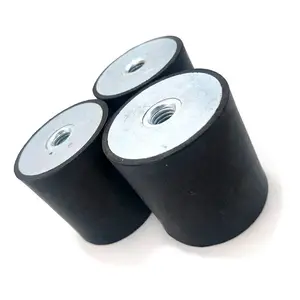Introduction to Rubber Dampers
Rubber dampers are essential components in various engineering and mechanical applications, known for their ability to absorb vibrations and minimize noise. Designed to provide effective cushioning, they play a crucial role in enhancing the lifespan of machinery, improving performance, and ensuring user comfort. With a diversity of designs suited to different applications, rubber dampers are indispensable in construction, automotive, aerospace, and industrial settings.
Types of Rubber Dampers
Understanding the types of rubber dampers available helps in choosing the right one for your specific needs. Here are the most common types:
- Isolation Dampers: Designed to isolate vibrations from sensitive equipment, ensuring smooth operation without disturbance.
- Shock Absorbers: Specialized dampers focusing on shock reduction, used primarily in automotive and heavy machinery to protect components.
- Mounting Pads: Used to support and stabilize equipment while reducing noise transmission; ideal for HVAC and industrial machines.
- Wave Dampers: These dampers aim to neutralize oscillations and are often utilized in applications such as bridges and building structures to reduce lateral movement.
Applications of Rubber Dampers
Rubber dampers find utility in a myriad of applications across various industries. Their ability to absorb vibrations and impacts enhances safety and performance in the following scenarios:
- Automotive Industry: Used in vehicles to improve ride comfort, reduce road noise, and prolong the life of mechanical parts.
- Aerospace: Essential in aircraft to manage vibrations and ensure precision in sensitive instruments while providing overall structural integrity.
- Construction: Used in buildings and bridges to mitigate seismic forces and structural vibrations, ensuring the longevity of the infrastructure.
- Industrial Machines: Commonly used in manufacturing equipment to reduce vibration and wear, thereby enhancing productivity and reducing downtime.
Features and Advantages of Rubber Dampers
Rubber dampers come equipped with a variety of features that make them advantageous for many applications:
- High Damping Capacity: Rubber offers superior energy absorption capabilities, effectively minimizing vibration and noise levels.
- Durability: Made from high-grade rubber compounds, these dampers are resistant to wear, weather, and various chemicals, ensuring a long operational life.
- Versatility: Available in multiple sizes and shapes, rubber dampers can be customized to suit specific applications, providing flexibility across different sectors.
- Cost-Effectiveness: By reducing wear and tear on machinery, rubber dampers lower maintenance costs and extend the lifespan of valuable equipment.
- Easy Installation: Their design allows for straightforward integration into existing systems, minimizing the need for extensive modifications.





















































